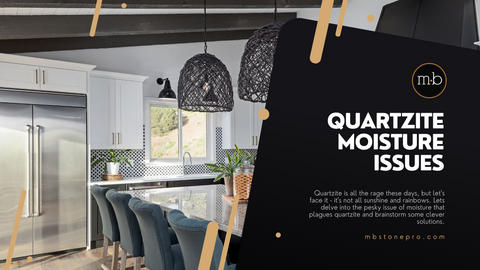
Quartzite Water Absorption Issues
Quartzite is all the rage these days, but let’s face it – it’s not all sunshine and rainbows. In this article, we’ll delve into the pesky issue of moisture that plagues quartzite and brainstorm some clever solutions. Stick around to see how it all pans out!
Quartzite Fabrication and Installation
Fabrication and installation of quartzite involve numerous factors, both during the process and in the aftermath. However, finding fabricators who thoroughly understand this material is challenging.
Running a fabrication shop is a demanding and high-overhead business, making it difficult to stay on top of every issue without proper education and reliable information.
The lack of readily available information from quarries and suppliers exacerbates the problem. The responsibility falls on fabricators AND the businesses that supply quartzite materials to continuously educate themselves to guide their clients effectively.
Ongoing Education in Quartzite Application
To address the issue, it is crucial for fabricators and businesses to invest time in educating themselves about quartzite.
While the knowledge of processing and protecting quartzite during fabrication and installation is relatively new, there are solid theories and emerging best practices.
The key is to continuously update and adapt to this evolving knowledge. If you want to steer your clients toward the right materials for their projects, it’s vital to keep up with the latest industry gossip and trends. A little knowledge goes a long way – and can save you and your client from some major heartache!
Quartzite Moisture Retention Issues and Long-term Management
Moisture-related problems with quartzite can occur during fabrication, installation, and even years later.
The primary challenge lies in the distinction between moisture issues arising immediately after fabrication and those that emerge in the future, unrelated to the work of fabricators and installers.
This creates a complex situation where it becomes difficult to assign blame. Homeowners, fabricators, and other parties involved should share the responsibility of educating themselves and conducting thorough research.
Moreover, there is a significant information gap between the fabricators and end users.
Quarries and suppliers lack direct experience with the domestic use of quartzite, which often leads to problems surfacing during fabrication.
Quartzite Moisture Retention Due to Resin Application
One crucial revelation in recent months is that quartzite materials quarried and processed for North America are treated with resin, while those destined for Europe and other continents are not.
Resin treatment, done for aesthetic purposes, inadvertently creates a less permeable layer on the surface that hinders moisture evaporation. As a result, the trapped moisture, along with mineral contaminants, leads to discoloration and saturation marks over time.
This entrapment can lead to prolonged dampness, eventually manifesting as dark wet marks or stains that are challenging to remove. Particularly, if the resin-coated quartzite is installed before it has adequately dried from fabrication processes like wet cutting, the risk of moisture retention increases significantly.
Furthermore, theories suggest that the polished edges of the stone act as barriers, reducing the rate of evaporation and causing water to accumulate within the surface. Another common issue that arises is the cracking or failure of caulking around sinks, which allows water to seep under the stone and worsen saturation and discoloration around the sink area.
Quartzite Water Absorption Issues Due to Acid Treatments
Acid treatments are primarily used on lighter-colored quartzites to eliminate iron-based minerals that could potentially cause staining. This process involves immersing the quartzite slabs in an acid bath for extended periods, which penetrates the stone and removes unwanted mineral deposits.
While this makes the quartzite visually more appealing and sometimes lighter in color, it can also increase the stone’s porosity, making it more vulnerable to staining and moisture retention.
One of the inherent risks with acid-treated quartzite is its increased susceptibility to absorb liquids. If not properly sealed post-treatment, the stone can absorb water and other staining agents more readily.
If the acid-treated slabs are not thoroughly rinsed or neutralized after the acid bath, residues from the treatment can attract and bind dirt, grease, and grime within the stone, complicating maintenance and cleaning efforts.
You Know What They Say, Prevention is Better Than Cure!
That’s certainly the case when it comes to dealing with moisture issues during fabrication and installation. But what about down the line? Sadly, we haven’t figured out a magic potion to cure moisture problems that may pop up later on. It’s a separate challenge that requires long-term moisture management tactics.
By understanding the problem, recognizing the lack of complete solutions, and acknowledging the complexity of the issue, businesses and homeowners can make informed decisions. While the information provided may be overwhelming, it emphasizes the need for ongoing education, collaboration, and research in the industry to mitigate potential issues with quartzite and ensure customer satisfaction.